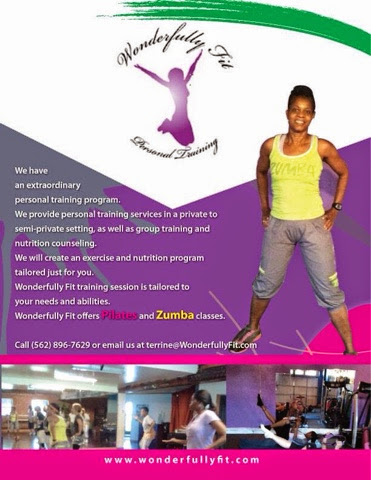Do not bounce while stretching. Instead, stretch as far as you can comfortably, and hold the stretch for up to 30 seconds.
Posts
Showing posts from 2014
PM INDOOR BOOTCAMP
- Get link
- Other Apps
Wonderfully Fit Studio offering PM INDOOR BOOTCAMP Starting January 6, 2015 Tuesday and Thursday @ 6:30 p.m. Receive a fitness assessment, such as body composition and measurements, to provide a baseline. You will be given general nutrition information and of course challenging, yet rewarding workouts. Workouts will consist of various exercises including: · Cardio, aerobics and salsa. · Resistance training using bodyweight, medicine balls, light dumbbells and resistance bands. · Foot work drills · Core training Get the tools you need to unlock a stronger, healthier version of yourself! Re-energize! 6 week boot camp term with renewals for as long as you want. Rates : $12.50 per person per class. Space is limited; reserve your place today. Class limit is 6. WONDERFULLY FIT PERSONAL TRAINING Long Beach, CA Terrine Pearsall, Trainer (562) 896-7629 terrine@wonderfullyfit.com Enroll Today
- Get link
- Other Apps
Join the bold, the brazen, the unintimidated. Join not having excuses. Join the idea that fun is the source of all joy. Join the unwillingness to give up. Join doing things your way. Join not joining. Join that purpose is stronger than outcome. Join your gut. Join the constant challenge of seeking greatness. Join play. Join the hunger to find what makes you happy. Join karma and nature and the effect you have on your world. Join your philosophy. Join something bigger than you. Join what you believe. Bode Miller, Olympian
- Get link
- Other Apps
ADVANCED PILATES AND PROPS CLASS -- SATURDAY Can You Make It? Saturday, February 15, 2014 @ 10:45 am Wonderfully Fit Studio 4180 Gardenia Avenue, LB COME JOIN US THIS SATURDAY This class is for anyone who has been practicing Mat Pilates for some time and is comfortable with moving through a steady pace and using props like Pilates Ring, Pilates Bands and Stability Ball. Tone and sculpt Your Body AWESOME CORE WORK!
